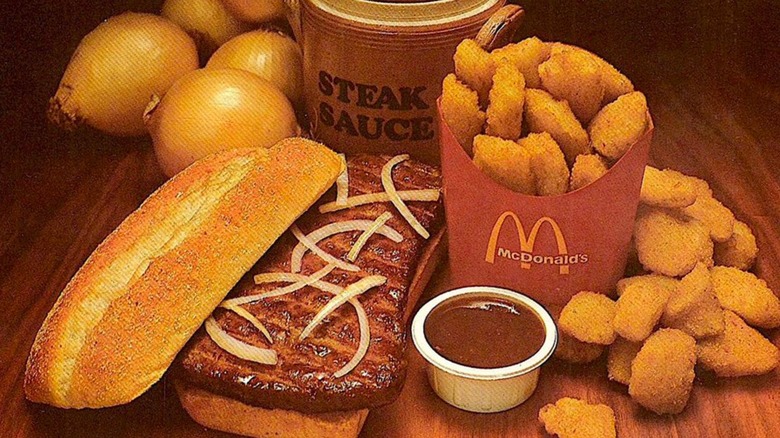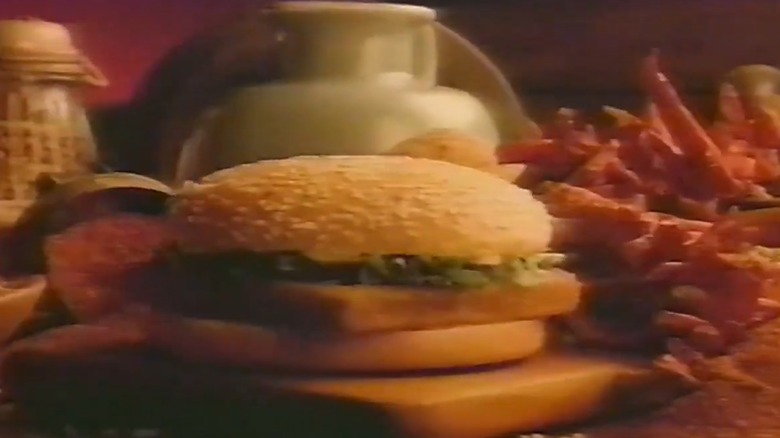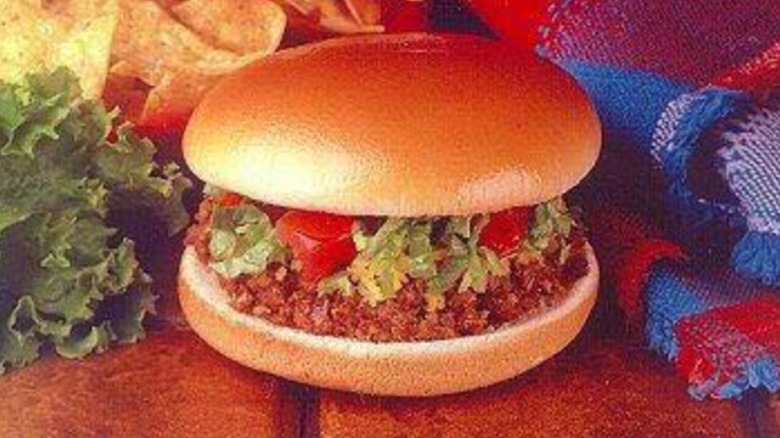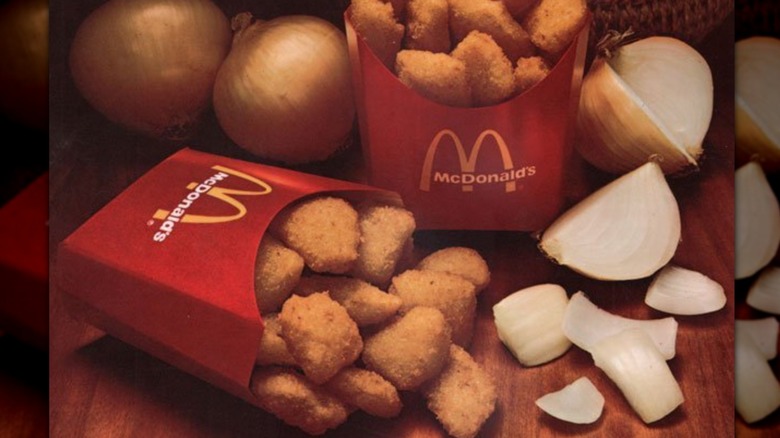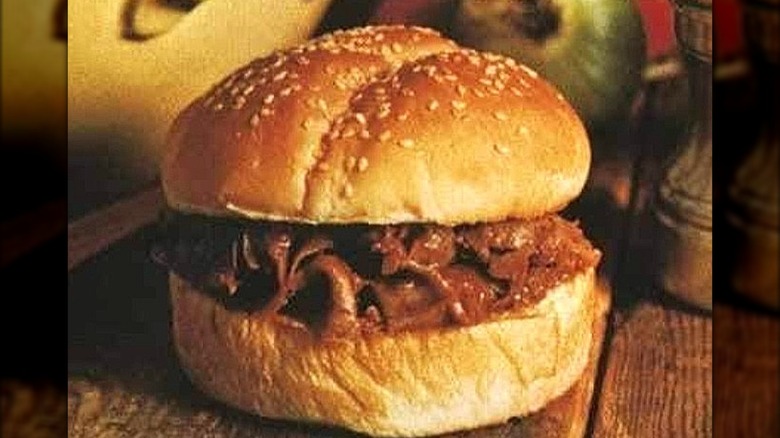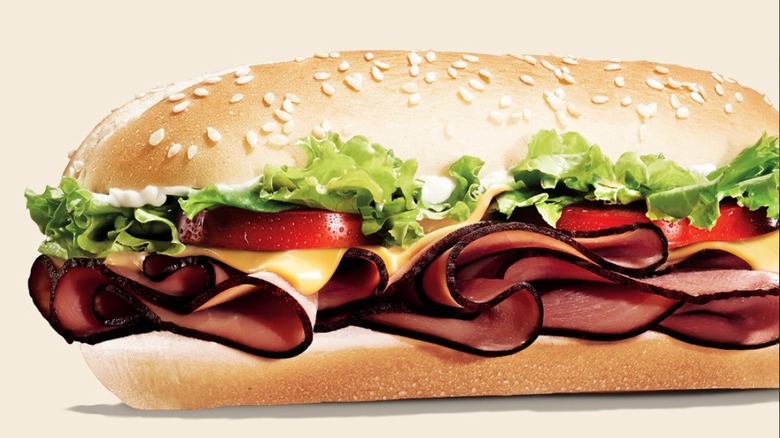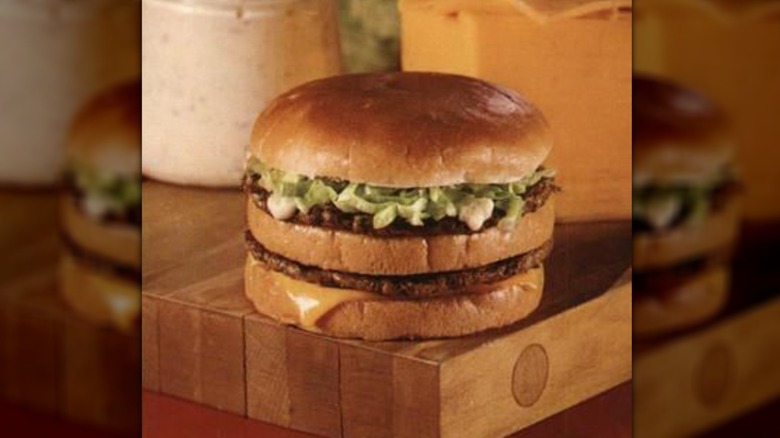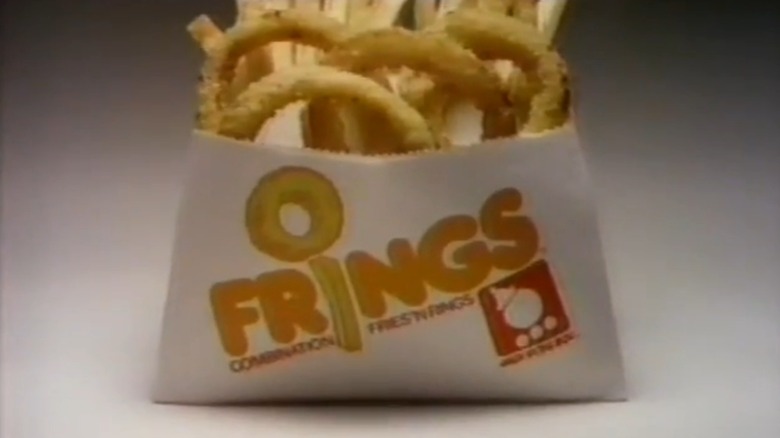Forgotten Fast Food Items From The '70s That We Want Back
How many fast-food chains can you name? We're willing to bet that you can reel off a lot of them, but also that you won't even scratch the surface of the true amount. In the United States alone, there have been countless fast-food chains throughout history. All of them are constantly vying for both your attention and your money, and as a result, fast-food restaurants seem to be in a constant race to produce new items that will keep a market that's spoiled for choice happy. However, as soon as they pop up, they die away again, leaving a lot of forgotten fast-food items out there.
If you're a child of the '70s, you'll no doubt remember a few favorites. The decade was a particularly exciting time for fast-food innovation, with plenty of chains going against the grain of their typical output and offering strange yet tasty fusion items. For example, Taco Bell's Bell Beefer combined Mexican-inspired flavors with classic burgers, while others, like the McDonald's Chopped Beefsteak Sandwich, took a winning formula and infused it with a casual sandwich format. You won't find these items, and plenty of others, in restaurants these days — and we think that's a huge shame.
Long John Silver's Peg-Legs
Long John Silver's has made its name by being the go-to spot for fried fish, but a lot of people forget that it also does fried chicken. Perhaps understandably, though, its poultry selection often pales in comparison to its seafood one. Back in the late '70s, Long John Silver's tried to rectify this by putting its fried chicken front and center and debuting its Peg-Legs meal. This option was a combo of fried chicken drumsticks and fries, served in a cardboard tray, much like the rest of their food. Both the drumsticks and the fries were dished up on a generous portion of crunchies, little pieces of fried batter which — as the name suggests — provide a delightful crunch in each mouthful.
Long John Silver's Peg-Legs were priced at just $1.49 in the 1970s, making them the cheapest meal you could get at the restaurant. This fact alone should have made them a winner, but for whatever reason, the Peg-Legs meal didn't quite take off, despite Long John Silver's heavily featuring its chicken in its commercials at the time. Perhaps folks just saw it as a seafood chain, as they do today. Soon, the Peg-Legs meal disappeared, and while it still serves up chicken options, they seem like a bit of an afterthought.
Burger King Whaler
First there was the Whopper, and then there was the Whaler. Burger King's Whaler sandwich comes across as a response to the way more famous Filet-O-Fish from McDonald's (which almost didn't exist). Clearly spotting a gap in its menu for a fish filet in a seeded bun, Burger King dutifully rolled up its sleeves and developed such an item. The result was a fish sandwich that felt like pretty much every other type out there: A breaded fish patty smothered in tartar sauce, crowned with a piece of lettuce, served in bread. Hey, it didn't reinvent the wheel, but we're willing to bet it was quite tasty.
The Whaler actually began life in the 1960s as a regional item. People clearly chimed with the sandwich, and by the mid-'70s it was gracing the main menu in Burger King's across the country. It remained popular throughout the '80s, with a Cajun Whaler also appearing that offered loads more spice. Unfortunately, as the '90s rolled around, enthusiasm started to wane on the Whaler. It eventually disappeared from the menu, and while Burger King has offered fish sandwiches since, a lot of people still hold a soft spot for the Whaler and its nautical name.
Taco Bell Bell Beefer Burger
As discontinued fast-food items go, few of them are as famous as Taco Bell's Bell Beefer. Perhaps it's because its name is such a tongue-twister, or maybe because it provided such a memorable mouthful. Taco Bell's Sloppy Joe-inspired burger first graced its menus back in the late 1970s, although it had existed as a chili burger before then. This burger was one of the five core menu items offered by Taco Bell from the very start of its operation.
However, Taco Bell ran into a problem pretty much instantly: the chili burger didn't contain chili. Instead, it contained meat spiced with taco flavors and flecked with tomato; it might look like chili, but it didn't quite taste like it. As such, Taco Bell duly changed its name to the Bell Burger, and then again to the Bell Beefer. The name stuck, and it became more popular than ever.
Throughout the '70s and '80s, the Bell Beefer Burger (which wasn't actually a burger, but that's besides the point) was a big deal. People loved the sandwich, and enjoyed the fact that they could enjoy those Taco Bell flavors in a slightly different format. Unfortunately, by the 1990s, its appeal was on the decline and it disappeared. Although Taco Bell did revive it briefly in 2012, it didn't stick around.
McDonald's Onion Nuggets
Do you know what came before McDonald's Chicken Nuggets? We'll give you a clue: It wasn't chicken. It wasn't even protein. In fact, it was onions. Yep, that's right: The forerunner of McDonald's Chicken Nuggets was actually its Onion Nuggets, a short-lived '70s fast-food menu item which was discontinued to make way for its famous all-timer.
Onion Nuggets were first pioneered by René Arend, the former executive chef for McDonald's, who was on the hunt to deliver classic flavors in different forms. They first hit McDonald's menus in 1976, and they stuck around for several years. Eventually, however, the vegetarian predecessor to everyone's favorite nugget experienced a rethink at the hands of chairman Fred Turner, who recommended to Arend that he should try out a chicken version instead of continuing to inflict chunks of deep-fried onion on the market. Arend agreed and tried out the first version of Chicken Nuggets, which soon became a smash success. Sadly, however, there was only room for one nugget on the McDonald's menu, and onion nuggets were removed for good.
Arby's Arby-Q
Arby's cornered the market for roast beef sandwiches, but it's not been content to rest on its laurels (and its flavors). Over the years, it's tested the waters as much as any other fast-food restaurant, and one result of its experimentation, the Arby-Q, was a real hit in the '70s. The Arby-Q, as you may have guessed, was a barbecue-inspired spin on the chain's classic roast beef. It took slices of its trademark meat and smothered them in thick, tangy barbecue sauce, all served on a sesame seed bun. Pickles and onions were added to the sandwich to give it a briney kick and cut through the density of the flavors.
The Arby-Q took off after being introduced in 1977, and for the rest of the decade it was everywhere. Its popularity continued into the '80s, where it underwent a rethink and started using a new barbecue sauce. By the time the '90s hit, however, the Arby-Q was starting to look a little old school, and Arby's took it off the menu. Not for good, though, as it's since shown up at various times as a limited edition item. Put it on the main menu, Arby's — we're begging you.
Pizza Hut Fiesta Taco Pizza
It's fair to say that the '70s was a time of great experimentation when it came to food, and the landscape of fast food at the time shows this pretty clearly. Pizza Hut's Fiesta Taco Pizza was the proof in the pudding of this push for innovation. This pizza-taco hybrid sought to fill in the blind spot between Mexican and Italian fast food, and piled a Pizza Hut base high with all of the ingredients you'd associate with a taco. Ground beef, cheese, and refried beans provided the heft for this menu item, salsa provided a touch of spice, and tomatoes and lettuce added freshness.
Pizza Hut's Fiesta Taco Pizza was introduced in 1979, but despite being a late addition to fast food in that decade, it made a splash fairly quickly. Nonetheless, the '80s and beyond were really the heydays for this pizza, which stuck around for a good few decades. Sadly, once the 21st century rolled around, the Pizza Hut Fiesta Taco Pizza was discontinued. There was never any official line for why it was no longer available — and we'd like to believe that Pizza Hut is biding its time until it brings it back again.
McDonald's Chopped Beefsteak Sandwich
We love it when McDonald's does something a little out there, as usually it's the most traditional fast-food joint of them all, serving up burgers and fries that all of us could pick out of a line-up. In the '70s, though, it decided to bring out its Chopped Beefsteak Sandwich, and the world rejoiced. This sandwich was simple but effective, made of a long beef patty topped with onions and covered in steak sauce. One of the distinguishing features of the sandwich was its oblong bun. Similar to the McRib, the shape gave it something a little special and helped it stand out from the rest of the pack.
Another thing that set the Chopped Beefsteak Sandwich apart was a side serving of Onion Nuggets, another McDonald's fave that didn't last very long. Neither did the Chopped Beefsteak: After a trial run, the restaurant eventually decided it didn't have what it took to make it long term. It eventually removed the Chopped Beefsteak Sandwich from its menu, and it's not been seen since.
Burger King Yumbo
There are no prizes for guessing what Burger King's main menu offering is, but back in 1971, it took a left turn from burgers and strayed into pure sandwich territory. The result was the Yumbo, a hot ham and cheese sandwich that spun the restaurant's menu on its head.
The Yumbo was originally served in a pretzel-like sandwich bun, giving it a sturdier look compared to the standard burger (although a couple of years later, it looked like it had reverted to Burger King's standard sesame bun). One of the best things about the Yumbo was the offers the restaurant would run on it; although it was typically priced at 79 cents, BK would frequently run two-for-one deals. That's a lot of ham and cheese for a reasonable price.
The Yumbo hit the ground running with Burger King customers, but people started to turn away from the sandwich after a couple of years. As a result, by the middle of the decade, some restaurants had started to remove it from the menu. The Yumbo stayed on Burger King's core menu for a while, though, until the 1980s saw its removal for good. Apparently, Burger King had come to the conclusion that the presence of the Yumbo was getting in the way of its other menu items. We think that it deserves a second spin in the United States. However, if you're willing to travel to the Cayman Islands, you might be able to find it at Burger King locations there, where a couple of years ago it was brought back to its main menu.
Burger Chef Big Shef
Spare a thought for Burger Chef. The Indiana-based chain began life in 1954, and people were swiftly drawn to its simple yet effective promise of burgers, fries, and shakes. Burger Chef quickly expanded and reached well over 1,000 locations across the country, before it began its slow, torturous decline and its eventual sale to Hardee's. During the '70s, though, it was still alive and kicking, and its Big Shef burger was arguably the most famous menu item around.
To be honest, there wasn't much between the Big Shef burger and other double cheeseburgers out there — but who doesn't love a big old sandwich? This burger came with two patties, a single slice of cheese, and some lettuce, with "Big Shef sauce" (that was apparently akin to a tartar sauce) that gave the whole thing a zing of flavor. Up until its eventual sale to Hardee's, the Big Shef was a big seller, but it eventually disappeared. However, back in 2007, Hardee's pulled a canny marketing trick out of the bag by bringing the Big Shef burger back in some of its Indiana stores. It didn't last very long, but it was a lovely blast from the past.
Jack in the Box Frings
Ah, yes, the eternal question: Do we want fries or onion rings with our fast food? Well, why not both? That was the proposition made in 1979, when Jack in the Box released one of those menu items that you probably forgot about: Frings. If you haven't figured it out by now, the word "Frings" was a combination of fries and onion rings, and that was exactly what this item was. Jack in the Box simply took its fries and onion rings, and put them in the same bag.
Let's be honest here; the restaurant didn't exactly roll out the greatest innovation with this one. Nor did it think especially hard about its ad campaign for the menu item: Frings were sold to the public as having the ability to make Saturday nights way more exciting, despite them being a very simple combo of two fried foods. Despite this, Frings were able to retain a place on Jack in the Box's menu for a couple of years, and although they were released in the late '70s, the early '80s were really their peak. That peak didn't last forever, though. Soon enough, Frings were unavailable, and people had to order the two sides separately.
